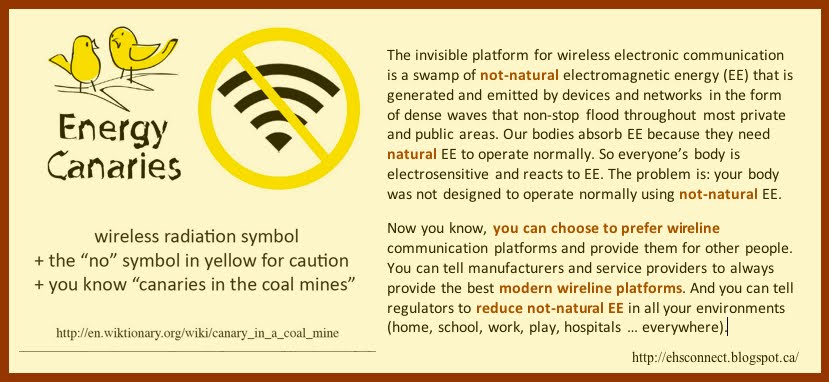The progressive way to use technology is to do it in a way that does not increase risk to health of humans and the environment. When any technology's use grows in such a way that ongoing increased risk to human or environmental health results, then that technology is no longer a technological advance, and it becomes the opposite of progress. Knowledge that there is ongoing increased risk requires that everyone actively encourage reduction in use of that technology, increased use of safer existing technology, and perhaps development of newer safer technology. Opting to instead encourage the status quo and stifle public awareness of risk is, at the very least, irresponsible. Opting to further and knowingly increase risk by encouraging increasing the use of the now unprogressive technology is inhumane, absurd, and grossly irresponsible. What are advances in technology? Isn't the root goal that hopefully they advance our lives? I certain don't want the definition of the word "advance" in the phrase "advance our lives" to be that the end of your life, my life, or anyone else's life is on an advanced timeline that ends sooner!
A perfect example of a technology that began as an advance and has become unprogressive is our present-day method of wireless one-way and two-way communications. In 2014, there are enumerable electricity-gobbling wireless connections and coverage areas that are at every moment and at ultra-high speeds multiply flooding into every nook and cranny of our indoor and outdoor airspaces—both everywhere we are and everywhere we aren't, and regardless whether or not any person or machine is using them. The invisible connections and coverage areas exist only because machines were invented that can consume the type of non-ionizing radiation called electricity (that we restrict inside wires and batteries), transform it into another type of non-ionizing radiation called radiofrequency, and spew that out in engineered densities to fill volumes of air. Engineers will tell you that radiofrequency energy cannot alter a living human; medical authorities will tell you that medical experts use radiofrequency radiation to purposely physically alter a human body or its functioning in cases where the medical expert feels some certainty or strong hope that the alteration will result in a benefit that outweighs risks.
Wireless communication radiation is an active polluter of our indoor and outdoor air; it isn't a by-product of some other activity. Millions or billions of times per second, and relentlessly, this radiation pollution floods into all our indoor and outdoor airspaces. This artifically-generated radiation enters into machines via specific engineered pathways, and the machines are programmed to react to the presence of this radiation in specific ways. The problem is that this artificially-generated radiation also enters any and all parts of a living body, not via specific pathways; and living bodies are born programmed to react to natural forms of this type of radiation, and in fact our survival depends on that always present natural radiation. So each moment that the artificially-generated radiation is entering a living body—at any and every area of the body that is being swamped—is some degree of radiation-overload. With such dense and relentless radiation-overloads, in each moment and/or over time, microscopic parts of a living body, or a living body as a whole, is undergoing these overloads and reacting to it. The point being that because that artificial radiation is relentlessly entering your body, your body must perform zillions more reactions than if that artificial radiation wasn't there. This is relentlessly onerous physical work for anyone's body—physical stress added to your body over and over and over again during every moment you're awake or asleep, at every moment you're alive.
Whose decision is it to continue to not encourage, and even further to discourage, the spread of common beneficial habits such as powering off personal wireless gear and networks when they are not in use? The waste of electricity, especially when everyone is asleep, is absurd. To want to inundate your own or anyone else's body with radiation pollution continuously while sleeping is also absurd. Further absurdity is to want to pay the price of the electricity and to want to pay it in order to needlessly irradiate your body and everyone else's while you're sleeping. All wireless connections are users generating both firsthand and secondhand radiation exposures, controllable by the user; all controllable coverage areas (indoors and outdoors; personal, private, and public) are sources of secondhand exposures, sometimes controllable by the user; other and bigger scale coverage areas and infrastructure are sources of secondhand exposures. Secondhand exposures are to users, non-users, and the environment.
So far, it is intended that these radiation pollution emissions be maximized to fill as much volume of air as possible and in unlimited numbers of overlapping densities. So far, there seems to be intention to maximize firsthand and secondhand exposures to this radiation for humans and the environment. This is now the opposite of progress. Continued use of this technology is irresponsible. Stifling public awareness of what "wireless" actually is in regard to firsthand and secondhand exposures is irresponsible. Expanding its use is the opposite of progress and is beyond irresponsible.

No comments:
Post a Comment